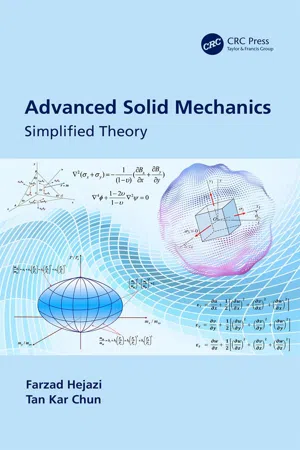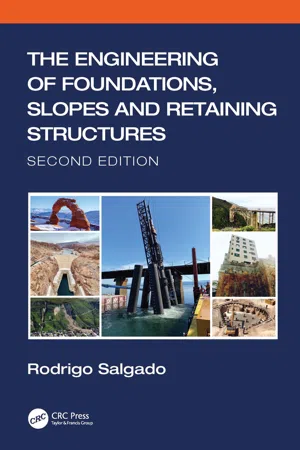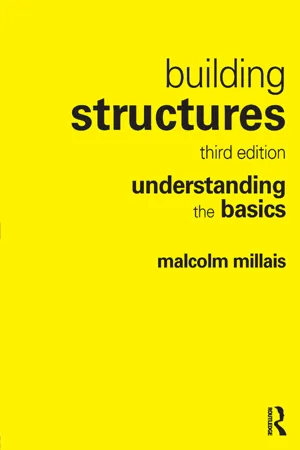Technology & Engineering
Shear Stress
Shear stress refers to the force per unit area that acts parallel to the surface of a material, causing it to deform or slide. It is a measure of the internal resistance of a material to shear forces and is important in the design and analysis of structures and materials. Shear stress plays a crucial role in determining the stability and strength of various engineering components.
Written by Perlego with AI-assistance
Related key terms
Related key terms
1 of 4
Related key terms
1 of 3
5 Key excerpts on "Shear Stress"
- eBook - ePub
- Robert L. Mott, Joseph A. Untener(Authors)
- 2021(Publication Date)
- CRC Press(Publisher)
shear . Shear Stress, of course, is a phenomenon of one layer of material tending to slide relative to the next layer. Shear Stress is very different from tension that pulls molecules apart or compression that tends to crush them together. Shear Stress, τ, was studied in previous chapters because of the cutting action of direct shear and the shearing stress that results when a member is loaded in torsion. In the case of bending, the shearing stress occurs horizontally along the length of beam, as one level of the beam is forced against the layers above and below it.As a designer, you need to be aware of this potential failure mode particularly in beams made of wood. The grain structure of wood does not provide strong resistance to shear along the grain lines, so wooden beams often fail in this way. In addition to wooden beams, any beam that has been made from multiple elements or layers joined by adhesives, welds, or fasteners must also be analyzed for shear. Other indicators for this failure mode are discussed later in the chapter. For now, look at the beam test performed in Figure 8–1 . The wooden beam has been placed in a three-point loading fixture on a universal testing machine as discussed in Chapter 2 . The test has been run to the point of failure for this wooden beam, and that failure occurred in shear. Look at the horizontal nature of the failure. Do you notice that the main area of failure is along the horizontal centroidal axis? This might be a surprise to you given that when analyzing bending stress, we referred to this as the “neutral axis” because of the lack of bending stress there. Failure in shear, though, actually quite commonly occurs along the horizontal centroidal axis because of the high shearing stress that occurs there.The test setup that you see in Figure 8–1 is precisely the type of test that would be used to determine values like those listed in Appendix A–15 - eBook - ePub
Advanced Solid Mechanics
Simplified Theory
- Farzad Hejazi, Tan Kar Chun(Authors)
- 2021(Publication Date)
- CRC Press(Publisher)
Fig. 2.3 ).where F is the normal force; A is the area of sectional plane.N o r m a l s t r e s s , σ =(2.1)F AFigure 2.2 Girder subjected to normal force.(2.2)whereV is the shear force;Avis the area of the shear plane.Figure 2.3 Girder subjected to shear force.2.2 Components of stressSolid mechanics studies the stresses and strains at any point on a body, usually illustrated using an infinitesimal cube enveloping the point. Since solids are three dimensional, we can define three mutually orthogonal axes by setting that point as centre. The stress and strain at this point can be categorised based on their direction, with each of them acting along a certain axis. Without other axes to be compared, the defined axes can be assumed not to have any inclination. This will be our reference axes, or global axes, as indicated in Fig. 2.4 .Figure 2.4 Stress components at a point.Suppose a force is exerted along the x-axis. The developed stress acting along the x-axis is distributed over the plane yz, which is the plane normal to the x-axis. The resultant stress is normal stress along the x-axis, σTable 2.1x. Meanwhile, the stress acting along the y-axis is distributed over the face of the plane yz, which often results in a change in the plane’s shape. The resulting stress is Shear Stress distributed along the y-axis due to the force acting parallelly on the normal plane of the x-axis, τxy. Similarly, τxzis known as the Shear Stress distributed along the z-axis due to the force acting parallelly on the normal plane of the x-axis. The notation for strain components can be interpreted in the same way. - Rodrigo Salgado(Author)
- 2022(Publication Date)
- CRC Press(Publisher)
1 Extremely large strains, particularly extremely large shear strains, are closely tied to concepts of rupture, yield, and failure. These three terms do not completely define the range of problems we deal with, so we will introduce appropriate terms throughout this chapter and the remainder of the text.4.1.2 Stress
A significant amount of the work we do in geotechnical engineering is based on the concept of stress. Stress is a concept from the mechanics of continuous bodies. Because soil is not a continuous medium, it is useful to discuss the meaning of stress in soils. Consider a small planar area A passing through point P located within a soil mass (Figure 4.1 ). A normal force FN and a tangential force FT are applied on A (these forces result, as discussed previously, from boundary loads and the soil self-weight or other body forces, which propagate through the soil mass until they reach the small area A). If soil were a continuum, the normal stress σ acting normal to A at point P would be defined as the limit of FN /A as A tends to the point P (that is, tends to zero, centered around P). The Shear Stress is defined similarly. Mathematically:Figure 4.1Definition of stress in soils: as the area A is allowed to shrink down to a very small value, the ratios FN /A and FT /A approach values σ and τ, the normal and Shear Stresses at P, respectively.σ =(4.1)limA → 0F NAτ =(4.2)limA → 0F TABecause soil is not a true continuum, we must modify this definition. A point within a soil mass is defined as a volume V0 that is still very small compared with the dimensions of the foundations, slopes, or retaining structures we analyze, but is sufficiently large to contain a large number of particles and thus be representative of the soil.2 With this representative elementary volume V0 , often referred to as the REV, we associate a representative area A0 (also very small, of a size related to that of V0 ). So we modify Equations (4.1) and (4.2) by changing the limit approached by the area A from zero to A0- Jerome Lange(Author)
- 2021(Publication Date)
- CRC Press(Publisher)
Stress and Strain4.1 STRESSStress is force divided by area, in the limit as the area approaches zero. For example, Fig. 4.1a shows a force dF which is exerted on an area dA on the end of a rectangular bar. The stress is a = dF/dA. Figure 4.1b shows the distribution of force over the entire end of the bar. Here the total is the sum of the forces dF, and the total area is the sum of the areas dA. Stress is usually expressed in pounds per square inch, which is often abbreviated as psi. Stress is a vector.FIGURE 4.1aFIGURE 4.1bNormal stress is stress for which the vector is normal, or perpendicular, to the area on which it acts. The stress represented in Fig. 4.1a is a normal stress. Normal stress is represented here by a (sigma).A normal stress is called a tensile stress (or tension) when it stretches the material on which it acts, as in Fig. 4.2a . A tensile stress is usually taken to be positive.FIGURE 4.2(a) Tensile stress; (b) compressive stress.A normal stress is called a compressive stress (or compressive) wheji it shortens the material on which it acts, as in Fig. 4.2b . A compressive stress is usually taken to be negative.Shear Stress is stress for which the vector is tangent to the area on which it acts. Figure 4.3 shows a Shear Stress acting on the end of a bar. Shear Stress is represented here by t (tau).FIGURE 4.3Shear Stress.4.2 STRAINStrain is deformation divided by the length in which the deformation occurs. Since strain is a length divided by a length, it is dimensionless. Strain is a vector.Normal strain- eBook - ePub
Building Structures
understanding the basics
- Malcolm Millais(Author)
- 2017(Publication Date)
- Routledge(Publisher)
This shows that for push and pull forces the sheet ‘thinks’ it is in tension and compression but the drawn sheet ‘thinks’ it is in shear. When the sheet has shear forces on the sides the situation is reversed and the drawn sheet ‘thinks’ it is in tension and compression. So, depending on how the element is cut from the structure, the type and the sizes of the stresses depend on the angle at which it is cut. The sheet example illustrates the two-dimensional case (as in the beam). In general, the element is a cube and the stresses are in three directions, the concept of rotating is the same but the diagrams would be distorted cubes.When Shear Stresses are absent, that is, there are only axial stresses, these stresses are called principal stresses. At some point in a structure a small cube positioned in some particular direction will, in general, have axial and Shear Stresses acting on the faces of the cube. To find the principal stresses at this point the cube must be rotated so that the Shear Stresses are zero. For the previous examples, push and pull forces cause principal stresses so no rotation is needed, but for shear the element must be rotated by 45º.Fig 4.11Generally, at any point in a structure, axial and Shear Stresses will exist. Depending on the numerical size of these stresses, the cube will have to be rotated a specific amount for the Shear Stresses to be zero. The stresses on the rotated cube will be principal stresses.Fig 4.12As the stresses vary in type and size from point to point of a structure under load, the principal stresses will vary in size and direction from point to point. To see what information principal stresses give, it is helpful to look at a simple beam loaded with a constant lateral load.Fig 4.13The beam transfers the lateral load to the supports by a system of internal forces that, in this case, are bending moments and shear forces. As before, the variation in the size of these forces is shown by bending moment and shear force diagrams.
Index pages curate the most relevant extracts from our library of academic textbooks. They’ve been created using an in-house natural language model (NLM), each adding context and meaning to key research topics.
Explore more topic indexes
Explore more topic indexes
1 of 6
Explore more topic indexes
1 of 4




